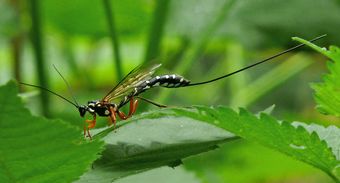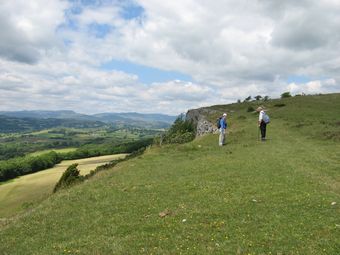 Giant Ichneumon Wasp, Rhyssa persuasoria14 participants were on the minibus for today's outing to Sizergh, where we divided into two equal groups. The more energetic embarked on a walk of about 6 miles to Scout Scar led by Donald. The botanical amblers did a less ambitious walk of about 5 miles(actually 2 short walks) led by Annie. I joined the amblers who initially set off on the North Loop which took in Holeslack and St John's Church, Heslington. Our gentle uphill route took us through open fields and then woodland where we spotted a song thrush on the path. For me one of the highlights was seeing a strange looking insect that I mistook for a dragonfly. I later discovered that it was an Ichneumon wasp (Rhyssa persuasoria), a parasitic species that preys on the larvae of other insects or spiders, especially horntails and wood wasps. A young dunnock was seen hiding in a shrub. We continued uphill past Holeslack farmhouse, a pretty white house now let out by the National Trust. The higher we climbed, the more splendid the views and our lunch stop at St John's Church afforded views towards Morecambe Bay, Whitbarrow and the Langdales. After lunch we explored the churchyard, some of which had been left unmown. We found twayblade here, but we were particularly delighted to find a lesser butterfly orchid. Numerous young birds were seen in the graveyard including great tit and nuthatch.The nuthatches still had very downy plumage. From the church we headed back down to Sizergh, where we picked up our second walk route, the South Loop which took us to Sizergh Fell. We walked along a road for some way where we saw a buzzard being harassed by a crow. We then headed across open fields again. 115 plants in flower/ferns were recorded including creeping cinquefoil, nipplewort, St John's wort, common spotted orchid and greater celandine which we used as herbal medicine. Speckled wood, orange tip and painted lady butterflies were recorded. Sue
Giant Ichneumon Wasp, Rhyssa persuasoria14 participants were on the minibus for today's outing to Sizergh, where we divided into two equal groups. The more energetic embarked on a walk of about 6 miles to Scout Scar led by Donald. The botanical amblers did a less ambitious walk of about 5 miles(actually 2 short walks) led by Annie. I joined the amblers who initially set off on the North Loop which took in Holeslack and St John's Church, Heslington. Our gentle uphill route took us through open fields and then woodland where we spotted a song thrush on the path. For me one of the highlights was seeing a strange looking insect that I mistook for a dragonfly. I later discovered that it was an Ichneumon wasp (Rhyssa persuasoria), a parasitic species that preys on the larvae of other insects or spiders, especially horntails and wood wasps. A young dunnock was seen hiding in a shrub. We continued uphill past Holeslack farmhouse, a pretty white house now let out by the National Trust. The higher we climbed, the more splendid the views and our lunch stop at St John's Church afforded views towards Morecambe Bay, Whitbarrow and the Langdales. After lunch we explored the churchyard, some of which had been left unmown. We found twayblade here, but we were particularly delighted to find a lesser butterfly orchid. Numerous young birds were seen in the graveyard including great tit and nuthatch.The nuthatches still had very downy plumage. From the church we headed back down to Sizergh, where we picked up our second walk route, the South Loop which took us to Sizergh Fell. We walked along a road for some way where we saw a buzzard being harassed by a crow. We then headed across open fields again. 115 plants in flower/ferns were recorded including creeping cinquefoil, nipplewort, St John's wort, common spotted orchid and greater celandine which we used as herbal medicine. Speckled wood, orange tip and painted lady butterflies were recorded. Sue
 Scout ScarThe rest of the group headed for Scout Scar. Approaching the bottom of the scar we encountered masses of wild strawberry in fruit which would have filled several bowls had we had time to pick them, but Donald, always with one eye on the clock to ensure a timely return to the minibus, ushered us past! The limestone outcrop not only gives extensive 360 deg views over Morecambe Bay, the Lakes, the Howgills and even Ingleborough peeping over the far horizon, but is a great habitat for many different species of plants, butterflies and birds. Amanda had joined this group as she was very keen to spot a dark green fritillary butterfly. We did see a fritillary amongst the many small heaths that were on the wing, but it was almost certainly a small pearl-bordered. There was a good variety of birds about - we also saw a buzzard being mobbed by crows but the highlights of our ornithological day were stonechat, tree pipit and redstart amongst the 31 species recorded on the day. Without Joan's expert presence we were unable to decide whether our butterfly orchids were greater or lesser, but the consensus was greater. Rock-roses abounded, mainly common but with a few hoary amongst them, and the delicate lemon colour of mouse-ear hawkweed contrasted with the rich blue of milkwort and these, together with other typical limestone plants such as wild thyme, juniper, and the local Lancastrian Whitebeam gave interest throughout our walk. Stuart
Scout ScarThe rest of the group headed for Scout Scar. Approaching the bottom of the scar we encountered masses of wild strawberry in fruit which would have filled several bowls had we had time to pick them, but Donald, always with one eye on the clock to ensure a timely return to the minibus, ushered us past! The limestone outcrop not only gives extensive 360 deg views over Morecambe Bay, the Lakes, the Howgills and even Ingleborough peeping over the far horizon, but is a great habitat for many different species of plants, butterflies and birds. Amanda had joined this group as she was very keen to spot a dark green fritillary butterfly. We did see a fritillary amongst the many small heaths that were on the wing, but it was almost certainly a small pearl-bordered. There was a good variety of birds about - we also saw a buzzard being mobbed by crows but the highlights of our ornithological day were stonechat, tree pipit and redstart amongst the 31 species recorded on the day. Without Joan's expert presence we were unable to decide whether our butterfly orchids were greater or lesser, but the consensus was greater. Rock-roses abounded, mainly common but with a few hoary amongst them, and the delicate lemon colour of mouse-ear hawkweed contrasted with the rich blue of milkwort and these, together with other typical limestone plants such as wild thyme, juniper, and the local Lancastrian Whitebeam gave interest throughout our walk. Stuart
